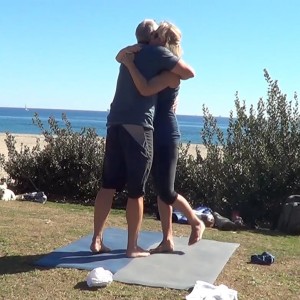 A question was posed to our Emotional Mindfulness class, taught by my good friend, Betsy Phillips, at Santa Barbara City College in the Spring semester this year and it was based upon the topic of “interdependence”. The answer was to be based upon our required readings (3 of the 5 text books we had for this course), which you will see in my response below. I hope you like my perspective on the topic of interdependence, as I think it adds value to our relationships with everyone all around us. The answer I submitted is not the “correct” answer – rather just my subjective understanding of the topic based upon my understanding of what the authors were teaching.
A question was posed to our Emotional Mindfulness class, taught by my good friend, Betsy Phillips, at Santa Barbara City College in the Spring semester this year and it was based upon the topic of “interdependence”. The answer was to be based upon our required readings (3 of the 5 text books we had for this course), which you will see in my response below. I hope you like my perspective on the topic of interdependence, as I think it adds value to our relationships with everyone all around us. The answer I submitted is not the “correct” answer – rather just my subjective understanding of the topic based upon my understanding of what the authors were teaching.
Question: “DESCRIBE THE CONCEPT OF INTERDEPENDENCE, FROM THE PERSPECTIVES OF RINPOCHE, THICH NHAT HANH AND SIEGEL.”
Rinpoche: “Interdependence, in Buddhism, particularly the Madhyamaka tradition, all phenomena are dependent on other phenomena for their existence. This includes the consciousness that labels a phenomenon. Being interdependent, all phenomena lack – are empty of – independence or inherent existence.”
In addition: The Middle Way is most clearly defined in the Madhyamaka philosophy. Madhyamaka is a critical Buddhist philosophy that developed in India, attributed to the third-century sage Nagarjuna. The view of the Middle Way cuts through the dualism of samsaric conditioning and transforms the practitioner’s understanding of reality. This view is the union of compassion and wisdom. As described previously, we normally see reality as permeated and conditioned by polar opposites – good versus bad, up versus down, enemy against friend. It is this narrow, closed-minded attitude that nurtures duality and is the root of suffering. The confusion that bring about the five poisons of hatred, desire, ignorance, jealousy, and pride is based on a false understanding of who and what we are. The confusion of our minds and hearts occurs when we fall to one of the extremes – eternalism or nihilism – rather than understanding and following the middle way between these extremes. The nature of all beings is neither absolute existence nor mere meaningless nothingness……
If we thoroughly understood that our nature is neither solidly well defined nor empty of all meaning, we would be free of our self-imposed suffering. We are empty of inherent existence but gloriously aware…..
The traditional practice of the Middle Way is to begin with an analysis of any and all phenomena in order to see that they are empty of inherent existence and that our identification of these phenomena is a form of artificial labeling imposed on constantly changing, interdependent events.”
Thich Nhat Hanh: “Methods you might use in order to arrive at liberation from narrow views, and to obtain fearlessness and great compassion: Interdependence, impermanency, and compassion. ….It (interdependence) is a penetration of mind into mind itself, using one’s concentrative power to reveal the real nature of the object being contemplated…..the subject of knowledge cannot exist independently from the object of knowledge. To see is to see something. To hear is to hear something. the great body of reality is indivisible. It cannot be cut into pieces with separate existences of their own. ….If the world did not exist, then the assembly of the five aggregates (which make up yourself) could not exist either….Consider the example of a table. The table’s existence is possible due to the existence of things which we might call ‘the non-table world’: the forest where the wood grew and was cut, the carpenter, the iron ore which became the nails and screws, and countless other things which have relation to the table, the parents and ancestors of the carpenter, the sun and rain which made it possible for the trees to grow……the meditation on interdependence is intended to remove the false barriers of discrimination so that one can enter into the universal harmony of life. It is not intended to produce a philosophical system, a philosophy of interdependence.”
Siegel: In Siegel’s book in discussing interdependence, is a passage on page 26, he argues the benefits of COAL: “COAL (Curious, Open, Accepting and Loving, as a parenting style) is exactly what parents who provide secure attachment to their children have as a mental stance toward them. We can propose that the interpersonal attunement of secure attachment between parent and child is paralleled by an intrapersonal form of attunement in mindful awareness. Both forms of attunement promote the capacity for intimate relationships, resilience and well-being.”
In comparing and contrasting the three authors, I rank their respective abilities to influence, me, the reader and novice meditation practitioner, in the following order:
1). Thich Nhat Hanh;
2). Rinpoche;
3). Siegel
Lastly, the key difference I see between Thich Nhat Hanh and Rinpoche in the issue of interdependence is that Rinpoche argues that it SHOULD be and is a philosophy, while Thich Nhat Hanh insists that to make the concept of interdependence a philosophy in itself, is a grave mistake and sin and would demonstrate that the practitioner has completely missed the ball, by getting caught up in the analysis of phenomena. If I am interpreting this correctly, I am a Thich Nhat Hanh fan and follower and believer.